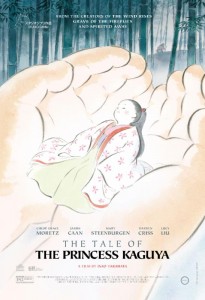By Rafael Villadiego (Nagasaki-ken 2010-2013), also available on Green Tea Grafitti.

Maiko wa Laaaaady
A comedic, Broadway-musical reworking of Audrey Hepburn’s classic My Fair Lady, wrapped in the traditional trappings of geisha and maiko regalia. Set amidst a backdrop of a contemporary Kyoto transitioning between the golden recollections of the past and the everyday realities of the present.
Taking place in the unobtrusive little corner of Shimohachiken – that was once an illustrious geisha district in its heyday, but has since fallen on hard times – it still seeks to uphold the old tea house traditions by maintaining at least one maiko in their district. Unfortunately, that maiko, Momoharu (Tabata Tomoko) is pushing 30 and longs to be released from her unfair restrictions and graduate into a true geisha.
Enter Haruko (Kamishiraishi Mone), a naive young country girl with her head full of dreams of becoming a geisha. After discovering a photograph of her late mother dressed as a maiko in her youth and reading Momoharu’s hapless blog, she eventually decides to leave her adoptive grandparents behind and make the journey to Bansuraku Teahouse in Kyoto. But, having no formal introduction or letters of recommendation, and plagued with a backward north-south country bumpkin accent, the odds seem stacked against her.
However, she is taken under the wing of local college linguistic specialist, Professor Kyono (Hasegawa Hiroki) who makes a friendly wager with another regular tea house patron Kitano (Kishibe Ittoku) that he can transform Haruko into a top notch maiko.
What follows is a singing and dancing extravaganza as a colorful cast of characters unfold all the pomp and circumstance of a Broadway musical, with a decidedly Japanese twist.
Veteran director Suo Masayuki of Shall we dance? fame returns to the fore with this whimsical musical confection that is sure to delight fans of musical theater. It is also a fine diversion for linguists of regional Japanese dialects or scholars of traditional geisha culture. In fact, Suo is a dedicated auteur of authenticity who offers delightfully disguised lessons in language, culture and tradition. Approaching his subject matter with gusto and treating it with the utmost reverence and respect – he also shows that he is more than willing to have some fun along the way.
Offering an exuberant display of traditional Japanese dance fused with western Broadway musical sensibilities, the film feels almost like an oxymoron, with its improbable mix of genres and styles. But somehow this unique juxtaposition just seems to work, as it sweeps audiences along on sheer energy and exuberance.
There is one particular musical number which plays perfectly on the classic lines of “The rain in Spain stays mainly in the plain”, but with a Japanese slant that more than makes it its own.
At the heart of this film is a classic underdog story, where if you are willing to try your best and weather the odds, you can overcome whatever comes your way and ultimately succeed. This is Haruko’s story, and we are invited along to share in her journey of discovery as we take a behind-the-scenes glimpse into the rarefied world of geisha and maiko culture.
In this regard, director Suo was fortunate to secure the services of newcomer Kamishiraishi Mone. Beating out 800 other applicants in the Toho Cinderella Contest, 16-year-old Kamishiraishi is quite a find and more than holds her own amongst the veteran cast in the demanding song and dance routines. We glimpse this world for the first time through her bedazzled eyes, with all the characters poised to perfection, the costumes colorfully coiffed and the sets exquisitely appointed.
But despite these elaborate production values, soaring songs and dazzling dance routines, there was just something missing that stopped the film from coming entirely together for me. It is hard to put my finger on exactly what was lacking. I am usually a sucker for a good song and dance, yet something prevented me from being swept off my feet completely. Perhaps the narrative around the musical was not as strong or believable as I would have hoped, to live up to the sheer exuberance on show. A fantastical confection, light as a feather, that possibly lacked the necessary substance to keep it grounded. The eventual low after the high.
Like a dream on waking.
[youtube http://www.youtube.com/watch?v=4rUDk3wpwms&w=500&h=300]
Lady Maiko (Maiko wa Lady) by Suo Masayuki, released September 13 2014 in Japan, starring Kamishiraishi Mone, Hasegawa Hiroki, Fuji Sumiko, Tabata Tomoko, Kusakari Tamiyo.
Eden Law (ALT 2010-2011 Fukushima-ken) reviews one of four Fukushima-related films in the 18th JFF. A fun fact: Homeland was partially filmed in the city of Iwaki, where he lived and worked as a JET. It’s good to hear the Tohoku dialect ringing in one’s ears once more!

Heck no, we won’t go!
The spectre of nuclear contamination from the 2011 catastrophe in Fukushima casts a dark and long shadow in “Homeland”, as a rice farmer (Soichi), his wife (Misa) and child, and his mother (Tomiko), struggles to cope after being forced to evacuate from their farm. Meanwhile, his estranged younger brother (Jiro) secretly returns to the forbidden zone and begins to tend to the ancestral home and lands, preparing the fields to plant traditional crops. It’s a quiet, meditative, at times slow film, though tensions simmer below the surface, and while the film’s focus is mainly on the human drama, much of the cause of that drama comes from the worries and issues that evacuees still face, three years on after the worst natural (and arguably man-made) disaster in Japanese post-war history.
Director Kubota’s first feature film (he had been a maker of documentaries before this) is also one of the first released for the Japanese domestic market that focuses on the lives of evacuees. Considering that the credits list special support from acclaimed directors Koreeda Hirokazu and Suwa Nobuhiro, this is probably a problematic topic for a movie in Japan right now, and therefore needed all the help it can get to be made. And it’s certainly not a pleasant reality that’s being depicted: the living conditions in temporary housing are cramped and impersonal; jobs, for people with no other career than farming, are scarce, living them with endless days and stupefying boredom (though Misa resumes her pre-marriage career as an escort), and the Soichi worries about the discrimination their daughter might face when she grows up. The refugees experience a sense of restlessness and hopelessness, feeling abandoned by the government. Some reviews of the film have criticised it for not taking a harder, clearer stance on social and political issues, but considering the depiction of hardships these characters face, it would be unfair to accuse it of whitewashing or ignoring the problems that people like Soichi and his family face.
The performances in “Homeland” are quiet, just like the film, with most of the heavy lifting concentrated in the roles of Soichi and Jiro, though Tanaka Yuko’s performance as the increasingly addled and distracted Tomiko, is heartbreaking to watch. And though Kubota somehow was able to film some of the scenes in the movie in the main streets of actual abandoned towns in Fukushima, for the most part the movie looks pretty pedestrian and staid, and would have benefited from a director more experienced in dramatic framing.
However, what Kubota intended to show is the human emotional state and reaction to the disaster, rather than exploring anything ideological, and in this he is largely successful. There is a yearning by displaced souls, caught in perpetual transit, for a home, to retain their dignity and also, to assuaged a collective sense of guilt for fleeing their ancestral homes. Jiro’s actions, in persistently living and farming on contaminated land, is definitely foolhardy and ill-advised, but one can understand the resolve and resilience of his spirit, seeking to triumph regardless of the odds, to quietly rebel against the government in a way, by not abandoning a place that so many others have. A film like “Homeland” is still important, if it means keeping alive in the nation’s consciousness, the lot of the abandoned and the lost of Fukushima.
[youtube http://www.youtube.com/watch?v=2oCxRUwG3GQ&w=500&h=300]
Homeland (Ieji) by Kubota Nao, released March 1 2014 in Japan, starring Matsuyama Kenichi, Uchino Masaaki, Tanaka Yuko, Ando Sakura and Yamanaka Takashi.
From the biggest Japanese film festival in the world, Eden Law (Fukushima-ken ALT 2010-2011) reviews an anthology from the most exciting names in Japanese anime at the moment.

Short and sweet.
Four short films (short pieces?) make up this anthology, an unashamed and exuberant exercise in creative muscle-flexing as some of the biggest names in anime take the helm: Shuhei Morita (“Possessions”), Katsuhiro Otomo (“Combustible”), Hiroaki Ando (“Gambo”) and Hajime Katoki (“A Farewell to Weapons”). In addition, a video game was released as part of this multimedia project, “Short Peace: Ranko Tsukigime’s Longest Day”.
“Plot” or “theme” is pretty loosely applied to Short Peace. Apart from sharing the same general vicinity, located somewhere not too far from Mt Fuji in central Japan, there is no connective narrative and each stands alone as a separate piece. They take place in different time periods of Japanese history, from ancient days to a post-apocalyptic future. The pieces are best enjoyed and experienced for their visual impact rather than for any story, for there is very minimal setup or backstory, and the term “style over substance” is vigorously embraced. Some backstory however, would have been useful, in order to make sense and provide context for the setting and events of some of the shorts.
Each director are wildly different in how they chose to tell their tales. The first chapter, “Possession”, is about an itinerant craftsman of sorts who, seeking shelter in a derelict and forgotten shrine from bad weather, finds himself assailed on all sides by tsukumogami, an endearing type of mischievous spirits or monsters formed from unwanted household objects. The use of CG is more overtly apparent, in the blocky design of the main character, and the technology’s usefulness in animating gorgeous detail is fully utilised, resulting in richly designed origami and textiles patterns filling the screen. This short was nominated this year for Best Animated Short category at the Academy Awards, and it’s not hard to see why: apart from its animation, the short has a fable-like quality in its story-telling, as the tsukumogami bemoan their lot, of being callously discarded after years of faithful service and so take out their frustrations on the lone mortal who have strayed into their world.
“Combustible”, the second chapter, is a love story between two young people whose families are neighbours. Forced apart by duty and social convention, they are reunited by the threat of a blaze that rages out of control in their block, a common and deadly hazard in the days of largely wooden cities. This piece draws more heavily on Japanese cultural heritage than the first, as it opens, quite literally, like a fine scroll painting, and simply looks stunning, departing radically from the usual anime style. Another fascinating aspect is the depiction of Japanese firefighting, which looks like a faithful recreation of real historical accounts and techniques. “Combustible” won several awards, like the Grand Prize at the 16th Japan Media Arts Festival and was also nominated for the Academy Awards for animation short last year.
In “Gambo”, the third chapter, a white bear comes to the rescue of a young girl against a giant demon that has been killing the men and kidnapping the girls. Incorporating several elements – the demon’s off-world origin is hinted at, and an injured samurai wears a crucifix – this is a dark and brutish short. The gore and violence is depicted graphically and copiously, and the animation style is coarse and thick, all in contrast to the elegance of the second chapter and the playfulness of the first. With its slightly cheesy dialogue delivered earnestly, and one-word-title film, It feels like a 70’s slasher-exploitation one-word-title film, as if children’s anime like the concept behind “Kimba” was given a radical adult makeover.
In the last, “A Farewell to Weapons”, what looks to be a mobile scavenging unit scours the ruins of a city looking for weapon supplies, and finds itself battling a superweapon, a leftover relic from some unknown war. It starts off a little bit “Top Gun” as the opening montage establishes the stereotypical character types common to every war film (the grizzled leader, the nerd, the lazy rebel, the guy who has dreams of a normal life after the army and who you just know would be the first to die, etc etc), but once into the action, Hajime Katoki’s experience from working on a lot of mecha-based anime (like “Patlabor” and “Gundam”) comes to the fore, creating some of the most exciting man-vs-machine combat sequences I’ve seen in a long while. The thought and attention put into thinking up possible methods of modern warfare and weaponry gives it an unexpected sense of realism, like some sort of futuristic “Hurt Locker”. The ending however, is rather anti-climatic, and while comical, seems a bit unsatisfying and slightly misjudged, given the tone that had been established.
“Short Peace”, despite some flaws, is a hugely enjoyable demonstration of animation and creative style. A welcome change from the usual uniformity of technical execution that dominates a lo of anime fare these days, and a strong powerhouse performance from Japan’s best.
[youtube http://www.youtube.com/watch?v=nFOws06p0cY&w=500&h=300]
“Possessions” by Shuhei Morita, “Combustible” by Katsuhiro Otomo, “Gambo” by Hiroaki Ando and “A Farewell to Weapons” by Hajime Katoki.

“Visually, the film is a treat, as the animators have combined elements of Japanese anime with Hollywood CGI-style animation.” (Walt Disney Pictures)
By Lyle Sylvander (Yokohama-shi, 2001-02) for JQ magazine. Lyle has completed a master’s program at the School of International and Public Affairs at Columbia University and has been writing for the JET Alumni Association of New York since 2004. He is also the goalkeeper for FC Japan, a New York City-based soccer team.
When the Walt Disney Company acquired Marvel Entertainment in 2009, it became inevitable that the superheroes in the comic book canon would find themselves headlining their own Disney movies. That notion came to fruition in 2012 when Disney released Marvel’s The Avengers, followed by the Thor, Iron Man and Captain America sequels. The lesser-known comic book superheroes collectively known as the Guardians of the Galaxy made their debut in 2014 and grossed an astounding $765 million worldwide.
Coming on the heels of that release is the latest Disney-Marvel collaboration, Big Hero 6—the first to be produced by its animation division. Unlike the other films, Big Hero 6 is aimed at the family audience so that it can entertain young children as well as teenagers and adults. It shares more in common with another Disney subsidiary named Pixar than its Marvel brethren. While it does not attain the high standards set by Pixar in such films as Toy Story, Monsters Inc. and The Incredibles (let’s face it—nothing does), it is an entertaining and fun movie.
Presumably the characters in Big Hero 6 are not well known outside the realm of comic book fandom—they don’t have the name recognition of Spider-Man, the Hulk, the Fantastic Four, etc. But the absence of brand recognition comes with a pair of trump cards: low preconceived expectations and the element of surprise. Many in the audience will be introduced to the characters and world of Big Hero 6 for the first time—and it is a remarkably innovative world.
JQ Magazine: Book Review — ‘Starting Point: 1979-1996’ by Hayao Miyazaki
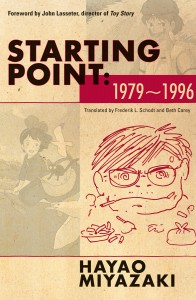
“For those who enjoy the process and precision behind an art, Starting Point is a rare glimpse into an often-times enigmatic industry.” (VIZ Media LLC)
By Alexis Agliano Sanborn (Shimane-ken, 2009-11) for JQ magazine. Alexis is a graduate student of Harvard University’s Regional Studies—East Asia (RSEA) program, and currently works as an executive assistant at Asia Society in New York City.
Starting Point: 1979-1996, translated by Beth Cary and Frederik L. Schodt, is quite unlike its sequel, Turning Point: 1997-2008 (read JQ’s review here). Technical rather than creative, Starting Point shares renowned director Hayao Miyazaki’s recollections of his early days as an animator. The essays and interviews follow anime through production development, touching on the intricacies of character design, layout, and story adaptation. For those who enjoy the process and precision behind an art, Starting Point is a rare glimpse into an often-times enigmatic industry.
The first half of the work features essays on Miyazaki’s long hours in the studio, culture, and nature of Japan’s animation industry in the 1960s and 1970s. As Miyazaki notes, even then, anime was tied to media mix marketing. You didn’t just have manga; you had manga, then an anime, toys, merchandise, and spin-offs all fueling off each other. Says Miyazaki in a 1982 interview: “The world of anime makes its business out of themes like departing for new horizons or love, while pretending not to be conscious of [the] commercial reality.” In hindsight, these remarks prove ironic; the auteur’s Studio Ghibli having similarly succumbed to commercialization.
It isn’t just media mix that remains the same today: professional frustrations were high and work-life balance poor. Miyazaki, over the course of several essays, recounts the life of a young professional. He states: “When young, nearly all of us want to be taken seriously, as soon as possible….In fact, many of those who have not yet taken the plunge into the professional world…tend to speak endlessly about techniques, or concentrate on gaining as much knowledge as possible….In reality, however, once you enter this industry, the techniques required can be mastered very quickly.”
JQ Magazine: Film Review — ‘The Tale of the Princess Kaguya’
By Lyle Sylvander (Yokohama-shi, 2001-02) for JQ magazine. Lyle has completed a master’s program at the School of International and Public Affairs at Columbia University and has been writing for the JET Alumni Association of New York since 2004. He is also the goalkeeper for FC Japan, a New York City-based soccer team.
When one hears the name “Studio Ghibli,” the director Hayao Miyazaki immediately comes to mind. Starting with Nausicaä of the Valley of the Wind in 1984, Miyazaki has continually delivered hit after hit for the past 30 years, making him the most successful contemporary Japanese filmmaker (animated or otherwise). Moviegoers can be forgiven for not recognizing the name of Miyazaki’s partner and Ghibli co-founder Isao Takahata, who tends to operate behind the spotlight. But Takahata is an accomplished animator and filmmaker in his own right.
In the West, he is best known for the extraordinary Grave of the Fireflies (1988), a powerful anti-war epic about the firebombing of Kobe during the Second World War. Roger Ebert considered Fireflies one of the best war films ever made, and it certainly ranks among Studio Ghibli’s greatest efforts, elevating the standards of anime depicting serious subject matter. Takahata’s other films were successful in Japan but received limited distribution in the West—notably the ecologically minded Pom Poko (1994) and the comic strip-inspired comedy My Neighbors the Yamadas (1999). From this selection of titles, it is clear that Takahata can work in a variety of genres with different animation styles. Unlike Miyazaki, he delegates much of the animation work and does not have an immediately recognizable aesthetic.
Last year, both Miyazaki and Takahata announced their retirements. For his swan song, Miyazaki released the controversial The Wind Rises (read JQ’s review here), which managed to receive criticism from both the political left and the right in its treatment of the war. Takahata decided to end his career with a project that he conceived and abandoned 55 years ago: A feature film version of the tenth century folktale The Tale of the Bamboo Cutter. Both films were to be released simultaneously in a show of solidarity, but production delays resulted in a later distribution for Takahata’s film. The film became a big hit domestically, and is now receiving its U.S. release under the title The Tale of the Princess Kaguya in both subtitled and dubbed versions.
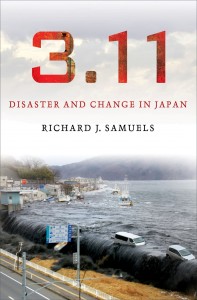
“Samuels draws from historical precedents and a rich and meticulously researched source material, as well as his extensive experience as a long-time observer and commentator on Japan, to produce a compelling and thought-provoking attempt to examine the true impact of the 3.11 disaster.” (Cornell University Press)
By Eden Law (Fukushima-ken, 2010-11) for JQ magazine. Eden currently serves on the JETAA New South Wales committee in Sydney, Australia as the online social media, webmaster and occasional editor. Got feedback? Leave a comment below.
The natural and man-made disaster of the 2011 Tohoku earthquake provoked an intense and visceral response from within and without, which saw an unprecedented level of cooperation between allies and between former enemies, and a united outpouring of human generosity and spirit globally. Little wonder then, that the usual cynical rhetoric was replaced with wholly credulous proclamations of a new age that could be an economic, technological, political and social rebirth of a nation.
“We expect a lot from crises,” author Richard J. Samuels notes in 3.11: Disaster and Change in Japan’s preface, and confesses to have himself been caught up in that same wave of optimism. What would the actual consequences be from the disaster? Would it bring a new era of “revival,” one of a number of slogans touted around Japan in the months following 3.11, or would the goodwill and its accompanying momentum evaporate in the face of reality that brings with it the problems of coping and dealing with a humanitarian disaster?
Samuels draws from historical precedents and a rich and meticulously researched source material, as well as his extensive experience as a long-time observer and commentator on Japan, to produce a compelling and thought-provoking attempt to examine the true impact of the 3.11 disaster. Starting with a description of the state of Japan around the time of the event, he describes a country in the economic doldrums, far from its position that it occupied decades earlier as an economic powerhouse that was the envy (and fear) of the developed world. Politically, Japan’s government had become a circus of ever-changing prime ministers, resulting in low public confidence in its leaders. Little wonder, then, that when the calamity of March 11th struck, the expectation and need for change seemed especially urgent and indeed, possible, more than at other time in recent Japanese history.
JQ Magazine: Book Review — ‘WA: The Essence of Japanese Design’
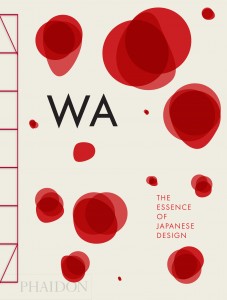
“WA is an excellent reminder that the analysis of everyday objects in our lives can be more insightful than we might first think, examining the roles of myriad mediums in Japanese daily life in ancient times to today including practical uses, religious ones, and political statements.” (Phaidon)
By Julio Perez Jr. (Kyoto-shi, 2011-13) for JQ magazine. A bibliophile, writer, translator and graduate from Columbia University, Julio is currently working at Ishikawa Prefecture’s New York office while seeking opportunities with publications in New York. Follow his enthusiasm for Japan, literature, and board gaming on his blog and Twitter @brittlejules.
Whether you like looking at furniture, crafts, art, and everything in between, in museums, magazines, or even Pinterest, you’re sure to appreciate the awe of a magical table, that from some angles is almost invisible, not to mention the rustic austerity of handmade materials for the Japanese tea ceremony and many other fascinating objects featured in WA: The Essence of Japanese Design. Throughout history, design and craftsmanship have had important roles in everyday life and practical uses, as well as in the arts and even in the political arena. WA explores the changing faces and development of Japanese design through the mediums themselves.
The book is divided into sections that include: Wood, Bamboo and Lacquer, Paper, Metal, Fabric and Textiles, Ceramic, and Synthetic/New Materials. Each section features a few dozen stunning photographs of objects, crafts, or even furniture, and a short essay that highlights pieces made from a particular material that, along with the photos, support its discussion about the development of that medium in Japan in a manner approachable for all readers. The contents of the book are written and selected by Rossella Menegazzo and Stefania Piotti, who are both scholars of East Asian arts and crafts, and they have successfully created a beautiful, approachable book on the subject.
WA explores the Japaneseness of Japanese design that has evolved throughout its history of ancient influences, from continental Asia and the Silk Road, through Japan’s periods of isolation, and continuing through today with its integration and innovation of Western design and cultural needs. WA is a very approachable book; the essays are not heavy with jargon and relate more to the pictures, which provides a very special and immediate connection to Japanese arts that would only be rivaled by holding the items themselves featured in the photos.
JQ Magazine: Book Review – ‘Colorless Tsukuru Tazaki and His Years of Pilgrimage’ by Haruki Murakami
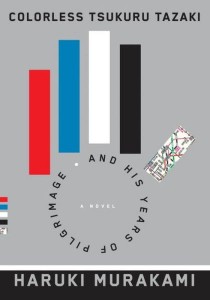
“Tsukuru Tazaki is more akin to a collection of related experiential pieces on existentialism rather than a straightforward story, which is why sometimes it can feel incomplete and unexplained. But there is a certain pleasure to be had from reading Murakami’s descriptive text, as he unhurriedly takes his time in building a backdrop by utilizing bits and pieces of asides and ephemera.” (Knopf)
By Eden Law (Fukushima-ken, 2010-11) for JQ magazine. Eden hails from the JETAA New South Wales chapter in Sydney, Australia, aging one hour at a time, his soul still empty, on the slow gentle slide to the eternal sleep of the grave. With the wind in his hair and a song in his heart, of course.
Haruki Murakami is a rare, superstar author who can engender the kind of excitement and anticipation more often seen with pop and movie idols. His latest novel, Colorless Tsukuru Tazaki and His Years of Pilgrimage, sold over a million copies in Japan in the first week, and overseas, the reception has been no less enthusiastic, with its release celebrated by midnight openings of bookstores with breathless fans queuing with anticipation.
Since its debut in English, the novel has topped the New York Times best sellers hardcover fiction list. As befitting such a book, it comes in a handsome dust jacket and cover designed by Chip Kidd, heavy with symbolism in blocked color bars and Japanese train routes peeking through plastic windows. Not all international covers for the book were created equally—check out this Tumblr gallery of all its international permutations, if you’re curious. It would seem that one doesn’t just read a Murakami novel; one experiences it.
I fully intended that last sentence to be facetious, but having finished the book, I’m not so sure I’m too far off the mark. In Tsukuru Tazaki, the author skillfully creates a world where characters are connected to each other by the most tenuous of relationships, gossamer-thin and fragile. For our eponymous protagonist, the most important relationship of his life—that with the only group of friends he has ever had—is suddenly and inexplicably severed, and he finds himself banished without explanation, causing a kind of spiritual trauma.
JQ Magazine: Book Review — ‘Japan 365: A Drawing-A-Day Project’
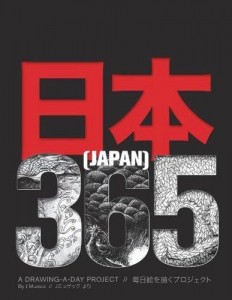
“Using nothing more than the simplest tools at hand to capture the moment, the artist establishes a tangible reality that lends an urgency and authenticity to the work that would not be possible in a more polished and composed form.” (J Muzacz)
By Rafael Villadiego (Nagasaki-ken, 2010-13) for JQ magazine. A member of JETAA New South Wales, Rafael is a collector of words on a journey still searching for a destination, who has a tendency to forget, we are all sometimes like the rain…
“If you attach a reason to an adventure, it ceases to be one.” –Uemura Naomi, noted Japanese mountain climber and adventurer.
「冒険に理由をつけると、冒険でなくなってしまう。」植村直己
There is something timeless and romantic about the idea of the wandering artist. Drifting aimlessly down untrodden roads and stumbling across hidden paths. Going wherever the wind might take them and all the while sketching random scenes from daily life, in all its raw and unfettered glory.
Japan 365: A Drawing-A-Day Project by current Melbourne resident J Muzacz (Kyoto-fu, 2010-12) is a drawing-a-day project that sets out to capture this sense of artistic wonder, in a fitting meditation on contemporary Japan. A black-and-white reproduction of sketches produced with nothing more than a simple ballpoint pen and notebook, the project sets aside all pretension and gaudy artifice and pares everything down to its barest essentials and fundamental simplicity. It is especially gratifying to see some pieces scribbled on the back of old pieces of paper or second-hand timetables. Using nothing more than the simplest tools at hand to capture the moment, the artist establishes a tangible reality that lends an urgency and authenticity to the work that would not be possible in a more polished and composed form.
While by no means an artist myself, there is something to be said about living the dream: An errant dreamer recording the world as they see it unfold. However, such whimsical fancy fails to fully appreciate the hard work and dedication inherent to such an undertaking. Consciously choosing to actively produce a completed work of art, every single day, for a solid year, is no mean feat. Having it ultimately culminate into such a hefty tome worthy of sitting comfortably on any coffee table or bookshelf, and feeling the solid weight of it all in your hands, is nothing short of remarkable. Artist/writer Muzacz and his supporters must be heartily commended for seeing it to fruition.
JQ Magazine: Book Review — ‘Year Zero: A History of 1945’
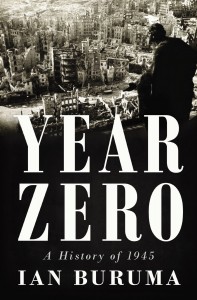
“Though so many of the complexities of World War II and ensuing changes can not easily be summarized, Buruma’s analysis of 1945 provides several enlightening answers that begin to answer the question of how and to what degree a sense of normalcy is achieved after destruction.” (Penguin Press)
By Sheila Burt (Toyama-ken, 2010-12) for JQ magazine. Sheila is a scientific writer at the Center for Bionic Medicine at the Rehabilitation Institute of Chicago. Read more of her writing at her blog.
Consider the following historic events: the bombings of Dresden begin; Franklin D. Roosevelt dies after serving 12 years as president; the B-29 bomber Enola Gay drops “Little Boy” on Hiroshima followed days later by “Fat Man” on Nagasaki, resulting in hundreds of thousands of deaths, unprecedented instant destruction, and long-lasting illnesses caused by radiation exposure; after six long, bloody years, the Second World War finally ends.
Now consider that all of these events took place in 1945.
Following these milestones in the span of only a few months, how could countries so deeply entrenched in World War II return to any sense of normalcy? How do you rebuild a broken nation?
Author and journalist Ian Buruma explores these questions and postwar disorder in his latest book, Year Zero: A History of 1945.
Writing about a single year (or several months within a single year) is not new—among a few other examples, Bill Bryson recently covered the summer of 1927 in One Summer: America, 1927; in 2010; cultural critic Fred Kaplan analyzed the significance of 1959 in his book 1959: The Year Everything Changed; and in 2005, Mark Kurlansky declared 1968 as The Year that Rocked the World.
For Buruma, a Luce Professor of Democracy, Human Rights and Journalism at Bard College and the author of several books, including the novel The China Lover, 1945 may not be more significant than other years but one of the most groundbreaking for transformations. Rather than focusing on the postwar efforts of a single country, Buruma looks at the countries destroyed or nearly destroyed by the ferocity of World War II, specifically narrowing in on the postwar chaos and change in Europe and Japan. “How did the world emerge from the wreckage? What happens when millions are starving, or bent on bloody revenge?” he asks in the prologue.
JQ Magazine: Manga Review — ‘Showa 1939-1944: A History of Japan’
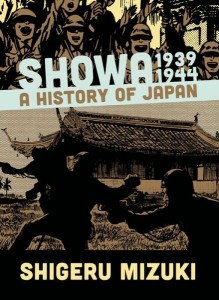
“Showa is an enjoyable book to read, and this volume in particular will appeal to those interested in World War II and comprehensible narratives of the political and military intrigue of the time.” (Drawn and Quarterly)
By Julio Perez Jr. (Kyoto-shi, 2011-13) for JQ magazine. A bibliophile, writer, translator, and graduate from Columbia University, Julio is currently working at Ishikawa Prefecture’s New York office while seeking opportunities with publications in New York. Follow his enthusiasm for Japan, literature, and board gaming on his blog and Twitter @brittlejules.
School might be out, but that doesn’t mean your educational summer reading can’t be fun. Welcome to part two of Shigeru Mizuki’s manga history of Japan during the Showa period! If you’re just tuning in or need a refresher, check out JQ’s review of the first book, Showa 1926-1939: A History of Japan. This series is translated beautifully in English by none other than JET alum Zack Davisson (Nara-ken, 2001-04; Osaka-shi, 2004-06) and published in North America by Drawn and Quarterly.
Illustrious manga artist Mizuki continues his retelling of the Showa period through his mouthpiece character Nezumi-Otoko (sometimes translated as Rat Man) of GeGeGe no Kitaro fame, and in this section includes events you have no doubt heard of such as the attack on Pearl Harbor and the Battle of Midway as well as ones you probably have not such as the Japanese campaign in the Dutch East Indies and the Battle of the Coral Sea, the first true incident of carrier warfare and air-to-air combat.
Mizuki also inserts his own autobiographical story into narrative, providing both a macro historical view and micro personal view of the war. As established in the previous volume, he has portrayed himself in a pretty poor light from the get-go, a good for nothing son that is too lazy to hold a job, can’t properly attend any school, and only seems to have a strong interest in eating as much food as possible. But the humble and comical portrayal of himself should be taken with a grain of salt, as Mizuki points out himself, in this era, “If we had a little food in our bellies, it was considered a blessing….We didn’t think about the future because we didn’t have one. Hard times at home were just the tip of the iceberg. After that there was the army, where all your future holds is an unmarked grave on a godforsaken island.”
JQ Magazine: Book Review — ‘A True Novel’
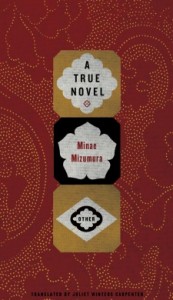
“A True Novel remarkably depicts the sense of isolation that anyone who has lived abroad or moved to a new place experiences. It captures the very human and conflicted desires to simultaneously fit into a society while also desiring to rebel against its impositions.” (Other Press)
By Julio Perez Jr. (Kyoto-shi, 2011-13) for JQ magazine. A bibliophile, writer, translator, and graduate from Columbia University, Julio is currently working at Ishikawa Prefecture’s New York office while seeking opportunities with publications in New York. Follow his enthusiasm for Japan, literature, and board gaming on his blog and Twitter @brittlejules.
This is the story of a poor boy that had the misfortune to fall in love with a rich girl. A classic Gothic tale of romance transplanted and re-imagined in postwar Japan. If you like your lovers star-crossed and your antiheroes of the rags to riches variety, then you’re in for a treat with Minae Mizumura’s A True Novel. Winner of the Yomiuri Literature Prize in 2002, A True Novel is a book filled with familiar themes executed in interesting new ways. It is a re-imagining of Emily Brontë’s Wuthering Heights in postwar Japan, with parallels among some characters, but different enough to be original and uniquely Japanese.
A True Novel is a unique and engrossing tale that brings together three seemingly unrelated characters who are united not only by a resigned sense of isolation from their surroundings but also united in their encounters and fascination with the book’s protagonist, Taro Azuma. The focus of the novel is the story of his tragic youth, a poor boy who falls in love with a rich girl, and his growing awareness that he would always be incompatible with her in the eyes of others. He flees to America, where he claws his way up from the dregs of society and overcomes the obstacles of class and wealth to become one of the richest Japanese men of his time. While we learn about his fascinating life through the three different viewpoints of the characters with their sometimes humanly biased perspectives, the book also gives insight into the complex identities of the uprooted lives of immigrants and refugees both in Japan and in America, as well as how attitudes toward them have changed over time. A True Novel remarkably depicts the sense of isolation that anyone who has lived abroad or moved to a new place experiences. It captures the very human and conflicted desires to simultaneously fit into a society while also desiring to rebel against its impositions.
Mizumura has masterfully brought to life narrators and characters from different generations, countries, and social classes, and provides fascinating insight into their lives during different periods of Japanese history. From the bleak years of Imperial Japan’s home front during the Pacific War, and the humbling postwar period, through its modern economic success, and finally to the bubble burst and recent events, Japanese modern history comes alive in an intimate and immediate way that inspires new appreciation and curiosity for the human side of history.
JQ Magazine: Film Review – JAPAN CUTS 2014 at Japan Society
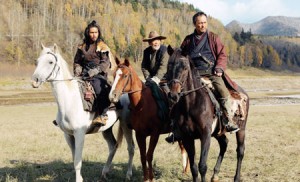
Ken Watanabe (right), stars in Unforgiven, premiering July 15 at Japan Society in New York as part of their annual JAPAN CUTS film festival. (© 2013 Warner Entertainment Japan Inc.)
By Lyle Sylvander (Yokohama-shi, 2001-02) for JQ magazine. Lyle has completed a master’s program at the School of International and Public Affairs at Columbia University and has been writing for the JET Alumni Association of New York since 2004. He is also the goalkeeper for FC Japan, a New York City-based soccer team.
This year’s JAPAN CUTS—North America’s biggest festival of new Japanese film—kicks off July 10-20 at New York’s Japan Society, continuing its tradition of showcasing the latest films from Japan along with some special guest stars and filmmakers. This year’s highlights include Japan’s blockbuster The Eternal Zero, The Great Passage (Japan’s submission for the Academy Award last year) and the post-3/11 documentary The Horses of Fukushima. Below are three of the 28 films in this year’s lineup that were made available to JQ at press time.
Eiji Uchida’s Greatful Dead marks the latest entry in the “dark and twisted” Japanese genre. The sordid story follows Nami (Kumi Takiuchi) as she follows “solitarians” (old and psychotic loners) around Tokyo and snaps selfies with them when they die. She enters into a morbid friendship with one particular “solitarian” (Takashi Sasano) and the rest of the film explores the darker side of humanity and mental illness in modern-day Japan. Uchida also seems to be making a statement about those most marginalized in modern Japan—the young and the elderly. Japan’s youth have a staggeringly large unemployment rate while the aging demographic makes for a perilously underfunded social security system.
Also using horror conventions for social satire is Miss Zombie, taking place in a futuristic Japan where zombies can be domesticated as servants and pets. Directed by Hiroyuki Tanaka (here using the pseudonym “Sabu”), Miss Zombie follows Shara, a mail order zombie whose owner, Dr. Teramoto, feeds her rotten vegetables in exchange for domestic labor. The film takes a darker turn as she is raped by two handymen—an event that sexually arouses Dr. Teramoto. Soon, Shara’s services are no longer limited to domestic chores. Even Dr. Teramoto’s wife finds her services useful after their son drowns. Overall, Sabu brings a fresh and interesting approach to the zombie film—a far cry from the works of George A. Romero and the countless imitators he inspired.
JQ Magazine: Book Review—‘Cinema of Actuality’
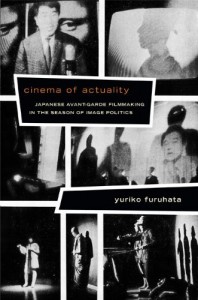
“Artists often make great sociological commentators, and Furuhata’s book sheds new light on the insights of these filmmakers.” (Duke University Press)
By Lyle Sylvander (Yokohama-shi, 2001-02) for JQ magazine. Lyle has completed a master’s program at the School of International and Public Affairs at Columbia University and has been writing for the JET Alumni Association of New York since 2004. He is also the goalkeeper for FC Japan, a New York City-based soccer team.
Yuriko Furuhata’s Cinema of Actuality: Japanese Avant-Garde Filmmaking in the Season of Image Politics examines a turbulent and disruptive period in Japanese history. As in other areas of the world, Japan in the late 1960s-early 1970s marked an era of youthful rebellion against the establishment, in both its public and private spheres. Furuhata’s analysis examines this period through the alternative Japanese film movements going on at the time, from New Wave figures like Masahiro Shinoda, Yasuzo Masumura and Hiroshi Teshigahara, to avant-garde filmmakers like Toshio Matsumoto and Kiyoteru Hanada. However, most of the films studied in the book are by Nagisa Oshima, largely considered to be the father of the Japanese New Wave and the “Jean-Luc Godard of Japan.” By eschewing the more traditional tendencies of the directors from Japan’s Golden Age such as Akira Kurosawa, Kenji Mizoguchi and Yasujiro Ozu, these directors incorporated such formalist experiments as jump cuts, disjointed angles, shaky handheld camerawork, pop music and, most importantly, the inclusion of television news footage.
Since many of these directors were relatively young, they shared the political sensitivities of the student protesters, who sanguinely staged media events to garner attention. The “season of politics” era was prominently displayed in nightly television newscasts, which covered a wide spectrum of politically disruptive events, from hijackings to hostage crises to mass student rallies and protests. The aesthetics of this new generation of film appropriated this contemporary media coverage in attempt to both reflect and critique it. By converging with other media cultures, these filmmakers engaged in a theory-filled dialog with the nature of representation itself, in effect becoming simultaneously media practitioners as well as theorists/critics. By making this powerful argument, Furuhata—an Assistant Professor of McGill University’s Department of East Asian Studies and World Cinema Program—forcefully disputes film scholar Noël Burch’s often-quoted notion that Japan was a cinema culture devoid of theory and serious study.

